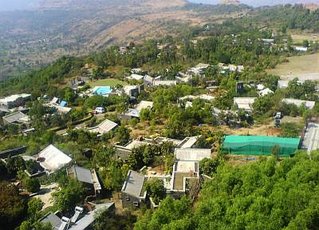Mahindra United World College - A Castle in the Sky

When I was asked to go with Hans and the rest of the DISHA volunteers to give a presentation at a nearby international school I was fairly indifferent to the idea although any excuse to get away from the computer for a day was an exciting prospect. Little did I know that the trip would have a pretty profound effect on me and I would still have vivid images running through my head a week later.
The school was called Mahindra United World College and was home to over 200 students (16 – 19) and 75 nationalities. It is perched on top of the mountain that it owns (yes, the school seems to own half the valley). The school is a maze of modern, angular stone and glass buildings, lush vegetation, green (rather than yellow) lawns and ponds filled with fish. One could not wish for a more beautiful place to live and study. It was a far cry from my inner city state school back in England and an even farther cry from the schools and labourers villages that lined the valley bottom. The stark contrast between Mahindra, a castle in the sky, and everywhere else I had seen in India made me feel uncomfortable and unnerved me somewhat. How could there be so much wealth living in such close proximity to so much poverty? It isn’t right although I have learnt that this is a question that can be asked all over India from Koregaon Park to the streets of Mumbai. The extremes are unimaginable but Mahindra seemed to accentuate them even more. I couldn’t quite work out why.
However, the longer I spent at the school the more relaxed yet jealous I felt. The students were in an incredible position to affect social change. It is a core requirement of their international baccalaureate to be involved with the creativity, Action and Service (CAS) programme and students spend three to four afternoons a week working in various social welfare projects. Obviously such wealth, when shared, can have a positive effect on the local area after all.
The students hold regular debates on everything from Sufism to gender and sexuality, weekly discussion sessions on issues of current global concern and follow a course that introduces them to Indian culture and philosophy. I felt that our HIV presentation would be almost redundant in such a liberal, educated environment. Don’t get me wrong, I know that HIV does not discriminate and is as much a problem among the wealthy as it is among the poor but I got the feeling they were going to know everything already.
I needn’t have worried however as Hans changed the focus a little in order not to patronise the students and his graphic, open and honest presentation was listened to attentively before being followed by a high level discussion that focussed on both HIV and the work of Deep Griha. By the end of the session I was feeling incredibly optimistic that a partnership between Mahindra and Deep Griha was on the cards. The school certainly have the resources to really help both Deep Griha and DISHA.
After a delicious lunch of paneer and papaya we drove down the mountain from the oasis that is Mahindra, returned to normality and was once again engulfed with an unnerving, uncomfortable feeling. I have been trying to shake it off ever since as Mahindra was an incredible educational establishment, doing amazing work and with Nelson Mandela, the honourary president of United World Colleges who am I to judge. Maybe I am just jealous.
0 Comments:
Post a Comment
<< Home